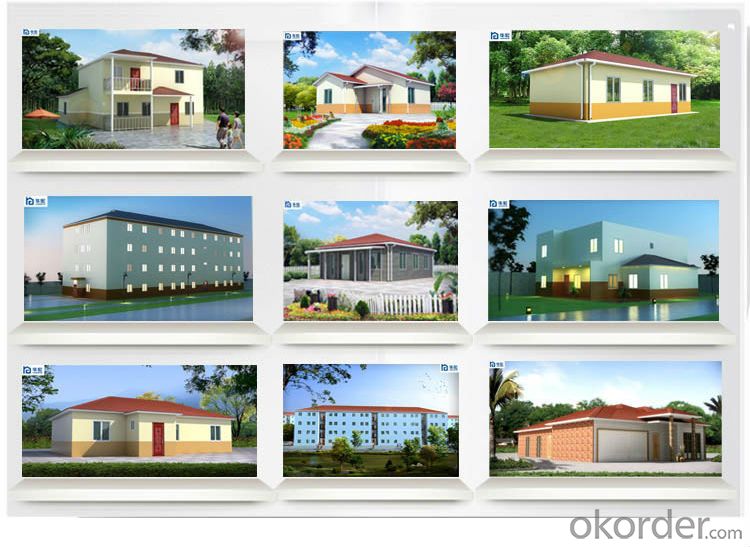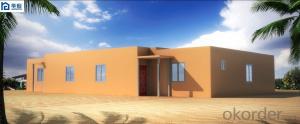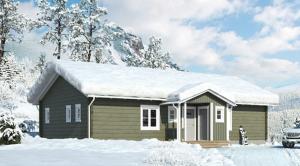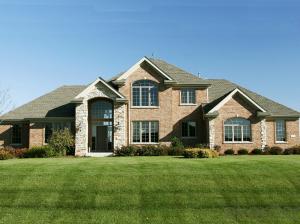Cement house from China
- Loading Port:
- China Main Port
- Payment Terms:
- TT OR LC
- Min Order Qty:
- -
- Supply Capability:
- -
OKorder Service Pledge
OKorder Financial Service
You Might Also Like
More questions:
1, What's your Payment term:
30% deposit by TT, 70% balance before loading container by TT; 100% LC at sight(total payment over 100,000USD);
2, How about Shipping:
We use 20 feet container and 40HQ container to ship the goods; Usually one 20 feet container can load about 50-60 square meters' house, 40HQ container can load about 120-140 square meters's house.
3, How to become your agent in our country:
First, you can make a report about your market, include the the rules and laws of prefab house, popular house models, target price, and potential sales quantity.
Second, you must place a trial order to act as the display.
Third, after finishing the sample house and getting the local people's feedback, we will give you the agent right in one area with limited time.
Fourth, Please note that we already have agent in Mumbai City India; Marshall Islands, Trinidad and Tobago.
4, Can you help me to purchase other things like furniture or appliance:
Because the customs law, our company can only export prefab house, so we just can purchase very little matched kitchen and bathroom facilities for you in consideration of customs clearance.
5, Can you send workers to help me build house.
Considering the labor cost, safety and visa issues, we suggest to send one or two engineers to guide and train your staffs. You must provide air tickets, hotel, and meal, and 100USD per day for engineer salary.

- Q:Can container houses be designed with a rooftop bar?
- Certainly, rooftop bars can indeed be incorporated into the design of container houses. These houses are incredibly adaptable and can be tailored to meet specific design needs. By carefully considering and engineering the structure, it is possible to integrate a rooftop bar into a container house's layout. The container can be adjusted and reinforced to bear the weight of the rooftop bar, while extra structural components can be added to ensure safety and stability. Additionally, the rooftop area can be fashioned to accommodate seating, a bar counter, and other amenities commonly found in bars. Through clever use of the rooftop space, container houses can optimize their functionality and create distinctive and inventive living environments.
- Q:Are container houses suitable for small businesses or offices?
- Container houses are a practical choice for small businesses and offices. Their adaptability allows them to be tailored to the specific requirements of a small business or office. Compared to traditional brick and mortar buildings, container houses are a cost-effective option, making them appealing to startups or businesses with limited budgets. Moreover, container houses provide mobility, easily being transported to different locations. This flexibility is advantageous for businesses that may need to relocate. Additionally, container houses can be swiftly set up, enabling businesses to commence operations in a shorter timeframe than constructing a conventional building. These structures can be modified to include essential amenities for small businesses or offices, such as insulation, plumbing, electricity, and HVAC systems. They can also be designed with separate rooms or areas to accommodate various functions, such as meeting rooms, workstations, or storage spaces. Furthermore, container houses demonstrate environmental consciousness as they are repurposed from shipping containers, reducing waste and promoting sustainable construction practices. They can also incorporate energy-efficient features, like solar panels or rainwater harvesting systems. To sum up, container houses offer an attractive solution for small businesses and offices, providing affordability, flexibility, and customization options. They are suitable for startups, remote locations, temporary offices, or businesses seeking an alternative and sustainable building choice.
- Q:What are the disadvantages of living in a container house?
- There are several disadvantages associated with living in a container house. One major drawback is the limited space available in a container. Since containers are originally designed for shipping purposes, they tend to be quite small and cramped, which can be challenging for individuals or families who require more living space. This can lead to difficulties in arranging furniture and storage, making it necessary to be creative with space utilization. Additionally, container houses may lack insulation, which can result in extreme temperatures inside the house. During hot summer months, containers can become unbearably hot, requiring additional cooling systems. On the other hand, during colder seasons, the lack of insulation can make it challenging to maintain a comfortable indoor temperature, requiring extra heating sources. Another disadvantage is the limited availability of natural light. Containers typically have small windows, which can make the space feel dark and gloomy. This lack of natural light can negatively impact mood and productivity, and may necessitate the use of artificial lighting throughout the day. Privacy can also be a concern when living in a container house. Due to their design, containers often have limited soundproofing capabilities, which means that noise from the outside or from neighboring containers can easily penetrate the living space. This lack of privacy can be a significant drawback for those who value a quiet and peaceful living environment. Furthermore, the process of obtaining permits and meeting building regulations can be more challenging when opting for a container house. Many areas have strict zoning laws and building codes that may not be easily met by container houses. This can result in a longer and more complex process to obtain necessary approvals, potentially leading to delays and higher costs. Lastly, the resale value of container houses may be lower compared to traditional houses. Container houses are still relatively new and unconventional, which can result in less demand from potential buyers. This can make it difficult to recoup the initial investment or make a profit if one decides to sell the property in the future. Overall, while container houses offer unique and eco-friendly living alternatives, they do come with a set of disadvantages such as limited space, insulation issues, lack of natural light, privacy concerns, challenges in obtaining permits, and potential lower resale value. Therefore, it is crucial to carefully consider these drawbacks before deciding to live in a container house.
- Q:What does the quadruple villa mean?
- Is home to enjoy the living outside the home, is the second place rather than the first home.
- Q:Can container houses be designed with a kitchenette?
- Yes, container houses can be designed with a kitchenette. While container houses may have limited space compared to traditional houses, they can still incorporate a functional kitchenette. The design can include a small cooking area with a stove or cooktop, a sink, countertop space for meal preparation, and storage for kitchen essentials. The kitchenette can be customized according to the needs and preferences of the occupants, making it a practical and convenient feature of a container house.
- Q:Are container houses suitable for sports or fitness facilities?
- Container houses can certainly be suitable for sports or fitness facilities, depending on the specific requirements and needs of the facility. Container houses offer several advantages that make them a viable option for such purposes. Firstly, container houses are highly customizable and can be easily modified to accommodate various sports and fitness activities. The open floor plan of container houses allows for flexible layout options, which can be tailored to fit different types of sports or fitness equipment. Additionally, containers can be combined or stacked to create larger spaces, making it feasible to design a facility that suits the specific needs of the sport or fitness activity. Secondly, container houses are cost-effective compared to traditional building methods. Constructing a sports or fitness facility using containers can be significantly cheaper than constructing a conventional brick and mortar facility. This cost savings can be crucial for sports or fitness facilities that may have a limited budget, allowing them to allocate more resources to equipment and programs. Moreover, container houses are portable and easily relocatable. This mobility can be advantageous for sports or fitness facilities that require flexibility in their location, such as pop-up fitness centers or temporary training facilities for events. Containers can be easily transported and set up in different locations, providing convenience and adaptability to changing needs. Furthermore, container houses are environmentally friendly. They utilize recycled shipping containers, reducing waste and promoting sustainability. This eco-friendly aspect can align well with the values of sports or fitness facilities that prioritize environmental consciousness. However, it is important to note that container houses may have limitations for certain sports or fitness activities that require large indoor spaces or specialized infrastructure. In such cases, a traditional building may be more suitable. Additionally, container houses might require additional insulation or climate control systems to ensure a comfortable environment for physical activities, especially in extreme weather conditions. In conclusion, container houses can be a suitable option for sports or fitness facilities due to their customizability, cost-effectiveness, portability, and environmental friendliness. However, it is necessary to carefully evaluate the specific requirements of the facility and consider any limitations before making a decision.
- Q:Can container houses be designed to maximize natural light?
- Yes, container houses can be designed to maximize natural light. Designers can incorporate large windows, skylights, and glass doors to allow ample sunlight into the space. Additionally, thoughtful placement of the containers and strategic use of materials can help redirect and amplify natural light within the house.
- Q:What are the sizes of container houses?
- Container houses, otherwise referred to as shipping container homes, are available in various sizes. The most commonly seen sizes are 20 feet and 40 feet in length. A container home that is 20 feet long typically offers around 160 square feet of living space, while a container home that is 40 feet long provides approximately 320 square feet. Nevertheless, these sizes can be personalized and adjusted to meet individual needs and preferences. Some container houses make use of multiple containers to create larger living areas. For example, the combination of two 20-foot containers can result in approximately 320 square feet of living space, and three 20-foot containers can provide around 480 square feet. Furthermore, container houses can be stacked or interconnected to create multi-level structures or spacious designs. This allows for greater flexibility in terms of size and layout, enabling the creation of larger container homes or even container home complexes. Ultimately, the size of a container house is determined by the number and arrangement of shipping containers used, as well as the customization and modifications implemented to meet specific requirements.
- Q:Are container houses suitable for areas with extreme weather conditions?
- Container houses can be suitable for areas with extreme weather conditions, but it depends on various factors. Proper insulation, ventilation, and reinforcement are crucial to withstand harsh climates. Additionally, modifications like using thicker insulation, reinforced framing, and weather-resistant materials can make container houses more resilient. However, it is essential to consult with experts and consider local climatic conditions before deciding on container houses in such areas.
- Q:Are container houses suitable for artist studios?
- Indeed, artist studios can indeed find suitability in container houses. The versatility of these structures enables them to be tailored to meet the unique requirements of artists. Furthermore, they present a cost-effective and environmentally friendly alternative to conventional studio spaces. By incorporating windows, skylights, and insulation, containers can be effortlessly transformed into spacious and well-lit studios. Moreover, their modular design allows for easy expansion or modification as the artist's needs evolve. Additionally, container houses offer the advantage of being positioned in various locations, granting artists the opportunity to work in secluded and inspiring environments. The durability of these structures ensures their ability to withstand the rigors associated with artistic endeavors. All in all, container houses provide a pragmatic and innovative solution for artists seeking a suitable studio space.
1. Manufacturer Overview |
|
|---|---|
| Location | |
| Year Established | |
| Annual Output Value | |
| Main Markets | |
| Company Certifications | |
2. Manufacturer Certificates |
|
|---|---|
| a) Certification Name | |
| Range | |
| Reference | |
| Validity Period | |
3. Manufacturer Capability |
|
|---|---|
| a)Trade Capacity | |
| Nearest Port | |
| Export Percentage | |
| No.of Employees in Trade Department | |
| Language Spoken: | |
| b)Factory Information | |
| Factory Size: | |
| No. of Production Lines | |
| Contract Manufacturing | |
| Product Price Range | |
Send your message to us
Cement house from China
- Loading Port:
- China Main Port
- Payment Terms:
- TT OR LC
- Min Order Qty:
- -
- Supply Capability:
- -
OKorder Service Pledge
OKorder Financial Service
Similar products
New products
Hot products




























